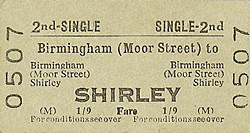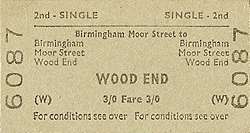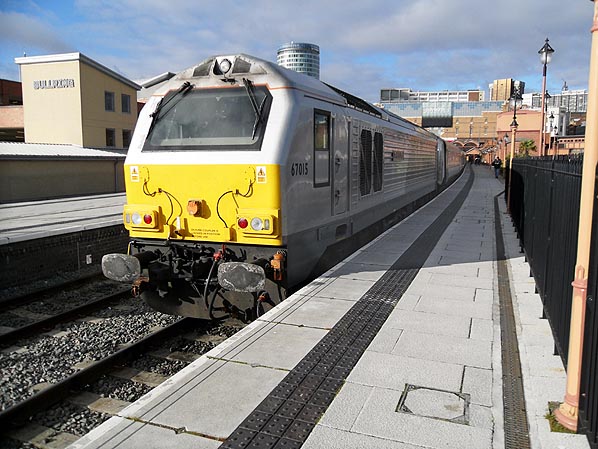|
Notes: The Great Western Railway (GWR) had served Birmingham since 1 October 1852, their main station being at Snow Hill. By the early twentieth century Birmingham Snow Hill was seriously congested and a re-build was undertaken from 1909 to 1912. Due to the limited space available at Snow Hill the rebuild could not solve all of the problems, so the GWR purchased land at Moor Street so they could build a new station for the local services that came into the city from the south.
The construction of Birmingham Moor Street was authorised under the GWR (New Works) Act of 1908 and building works began during September of that year. The station opened on 1 July 1909, comprising of a single island platform 700ft in length with two faces, and temporary buildings housing the usual staff and passenger accommodation. The permanent station buildings would not be authorised until 1911 due to the building of a low level goods station directly below the station. The station was located to the east of the street after which it was named and to the west of the London and Birmingham GWR main line. A short branch (the Moor Street branch) connected the station to the main line. To relieve congestion on the southerly approaches extra relief lines were laid from Bordesley through to Moor Street, opening on 16 November 1913. With the completion of work on the low level goods facility during 1914 the temporary staff and passenger accommodation was replaced with permanent structures.
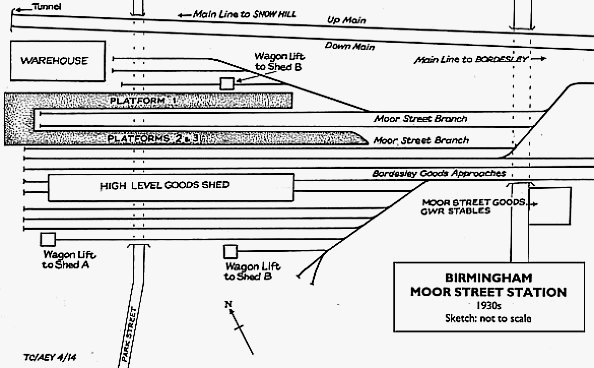
In 1930 the station was both enlarged and extended, and an extra single face platform, 600ft in length, was added. This was located between the main lines from Snow Hill and the existing island platform. The booking office was housed within a modest brick and terra cotta building with arched openings.The platforms were numbered 1 to 3 with platform 1, dating from 1930, located to the east. Platforms 2 and 3 were the original island platforms and they had a canopy which extended to approximately half of the platform’s length.
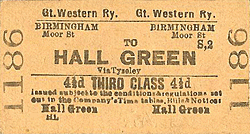 An interesting feature at Moor Street was a pair of traversers, 60ft in length, located adjacent to the buffer stops. It allowed locomotives to be moved onto an adjacent line so that they could run around their trains. The installation of the traversers meant that points were not needed at the north end of the station, which saved space. An interesting feature at Moor Street was a pair of traversers, 60ft in length, located adjacent to the buffer stops. It allowed locomotives to be moved onto an adjacent line so that they could run around their trains. The installation of the traversers meant that points were not needed at the north end of the station, which saved space.
Passenger services ran to Shirley, Henley-in-Arden and Stratford-upon-Avon, serving the local stations along the line on Monday-to-Saturday only. On Sundays trains ran through to Snow Hill which was quiet enough on that day to accommodate them.
The July 1922 timetable showed 21 departures from Birmingham Moor Street on Monday to Friday with 19 on Saturday, and 23 arrivals Monday to Saturday. Trains ran mainly to and from Shirley and Henley in Arden with 4 services per day through to Stratford-upon-Avon.
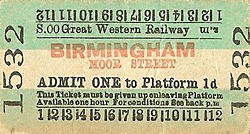 On 1 January 1948 Birmingham Moor Street became part of British Railways (Western Region). In the immediate period after Nationalisation services continued to run to Henley-in-Arden and Stratford-upon-Avon although some trains ran only as far as Earlswood Lakes. In the summer of 1949 there were 20 departures and 24 arrivals on Monday-to-Friday. There were two fewer departures and six fewer arrivals on Saturday, and the station continued to be closed on Sunday. On 1 January 1948 Birmingham Moor Street became part of British Railways (Western Region). In the immediate period after Nationalisation services continued to run to Henley-in-Arden and Stratford-upon-Avon although some trains ran only as far as Earlswood Lakes. In the summer of 1949 there were 20 departures and 24 arrivals on Monday-to-Friday. There were two fewer departures and six fewer arrivals on Saturday, and the station continued to be closed on Sunday.
BR Western Region totem signs were fitted in the late 1950s. About the same time DMUs were introduced onto many of the services that ran to and from Moor Street.
On 1 January 1963 the former GWR lines in Birmingham were transferred to the London Midland Region. British Railways saw the line between Birmingham Snow Hill and London Paddington as a duplicate route. From 1966 a number of main line services from Snow Hill ceased to run and others were diverted to Birmingham New Street. On 4 March 1968 the line between the junction with the Moor Street branch and Birmingham Snow Hill closed, and it was lifted shortly after. Birmingham Moor Street became the northern terminus for the former GWR lines. The LMR proposed that passenger services into Moor Street would cease by the commencement of the summer timetable on 5 May 1969. Five local authorities objected and would take the case to the High Court; the court sided with the local authorities on the grounds that the removal of the services would cause undue hardship, and thus prevented the closure of Moor Street.
By 1967 all of the services used DMUs, and on 17 December 1967 the traversers were taken out of use.
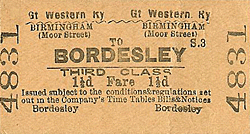 By the 1970s the services running out of Moor Street were supported by the West Midlands Passenger Transport Executive (WMPTE) whose branding was applied to the station. The 5 May 1975 timetable showed 28 departures on Monday-to-Friday with 17 on Saturday, and 26 arrivals on Monday-to -Friday with 17 on Saturday. There had been a significant change by the 1970s with trains arriving at Moor Street having come from Didcot, Banbury, Leamington Spa, Oxford and Stratford-upon-Avon. Strangely there were no corresponding return services; all of these ran to Leamington Spa or Stratford-upon-Avon. By the 1970s the services running out of Moor Street were supported by the West Midlands Passenger Transport Executive (WMPTE) whose branding was applied to the station. The 5 May 1975 timetable showed 28 departures on Monday-to-Friday with 17 on Saturday, and 26 arrivals on Monday-to -Friday with 17 on Saturday. There had been a significant change by the 1970s with trains arriving at Moor Street having come from Didcot, Banbury, Leamington Spa, Oxford and Stratford-upon-Avon. Strangely there were no corresponding return services; all of these ran to Leamington Spa or Stratford-upon-Avon.
The goods facilities at Moor Street closed on 6 November 1972.
By the early 1980s passenger numbers on the local services in the Birmingham area had increased and Birmingham New Street had become congested. Remarkably, even though Snow Hill had been closed 6 March 1972, the WMPTE considered reopening it. Plans were drawn up and a new Birmingham Snow Hill was built on the site of the original. The original GWR main line was re-laid into Snow Hill from the south and as part of the works a new Moor Street station was built on the main line just to the south-east of the point where it passed into the Snow Hill Tunnel.
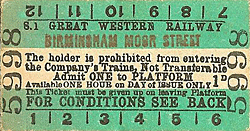 The new through station at Moor Street opened on 28 September 1987, with the original terminus seeing its final departure on 26 September 1987. The new Snow Hill station opened on 5 October 1987 and services once again used the broad gauge tunnel under the city. The new through station at Moor Street opened on 28 September 1987, with the original terminus seeing its final departure on 26 September 1987. The new Snow Hill station opened on 5 October 1987 and services once again used the broad gauge tunnel under the city.
The buildings at Moor Street were Grade II listed and therefore could not be demolished, but by the end of the 1990s they were in a poor state of repair.
The original buildings and platforms were refurbished and were linked to the 1987 Moor Street station at a cost of £11 million in 2002. The project saw the demolition of the 1987 station entrance; the new entrance being through the original station. The refurbishment was done in a 1930s GWR style which was also applied to the 1987 station platforms. The result was aesthetically pleasing and created one station out of two.
Even though the original platforms had been refurbished, no trains could run from them as they were no longer physically connected to the railway network - the Moor Street branch having been disconnected at the point where it met the alignment of the former GWR main line. An ex-GWR steam locomotive, No.2885, was placed at the buffer stops of platform 3 as a feature of interest.
In 2004 there were 161,000 passenger journeys from Moor Street.
The reopened Birmingham Snow Hill was a great success, and by the 1990s it was suffering from capacity problems. Services to London (Marylebone instead of Paddington) had been reintroduced in 1996 which caused further difficulties with capacity.
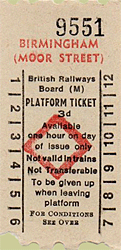 In June 1996 M40 Trains, later Chiltern Railways, won the franchise to run the Birmingham Snow Hill to London Marylebone services. The company originally consisted of a number of ex-British Rail (BR) managers, John Laing construction, and 3i. In March 1999 John Laing acquired the 3i stake in the company, along with some of the shares held by the ex-BR managers thus holding 84% of the company. Following the acquisition of the remaining 16%, from the ex-BR managers, Laing was sold to a private equity firm only to be sold on to Deutsche Bahn in 2006. In early 2011 Chiltern Railways was absorbed within the Arriva Group and now has Arriva Trains as its parent company. Contained within the franchise proposals was the reopening of the original Birmingham Moor Street station in order to ease the congestion at Snow Hill. The original platforms reopened on 11 December 2010, the branch having been reconnected to the main line. The first departure from the reopened platforms was a steam special that ran to London Paddington and then returned to Moor Street. In June 1996 M40 Trains, later Chiltern Railways, won the franchise to run the Birmingham Snow Hill to London Marylebone services. The company originally consisted of a number of ex-British Rail (BR) managers, John Laing construction, and 3i. In March 1999 John Laing acquired the 3i stake in the company, along with some of the shares held by the ex-BR managers thus holding 84% of the company. Following the acquisition of the remaining 16%, from the ex-BR managers, Laing was sold to a private equity firm only to be sold on to Deutsche Bahn in 2006. In early 2011 Chiltern Railways was absorbed within the Arriva Group and now has Arriva Trains as its parent company. Contained within the franchise proposals was the reopening of the original Birmingham Moor Street station in order to ease the congestion at Snow Hill. The original platforms reopened on 11 December 2010, the branch having been reconnected to the main line. The first departure from the reopened platforms was a steam special that ran to London Paddington and then returned to Moor Street.
By 2011 there were over 6 million passenger journeys being made from Birmingham Moor Street.
In 2014 Birmingham Moor Street station had 98 departures on Monday-to-Saturday. Destinations served included Birmingham Snow Hill, Kidderminster, London Marylebone, Stratford-upon-Avon and Stourbridge Junction, with Chiltern Railways and London Midland operating from the station.
Tickets from Michael Stewart and route map by Alan Young.
Sources:
|

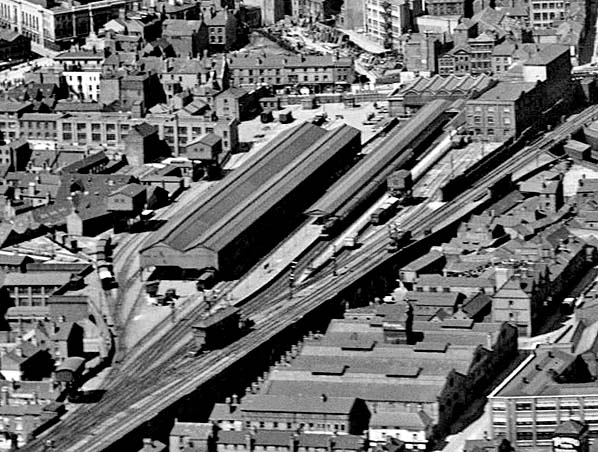
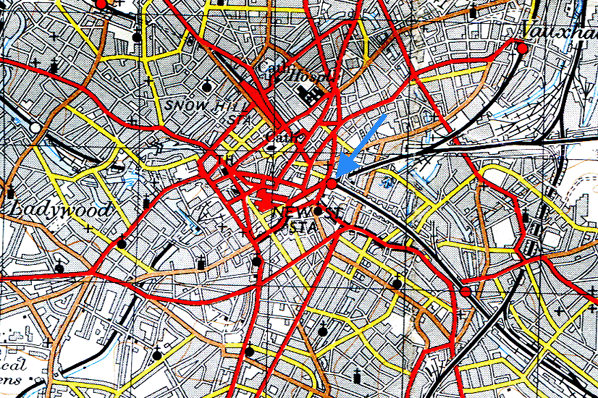
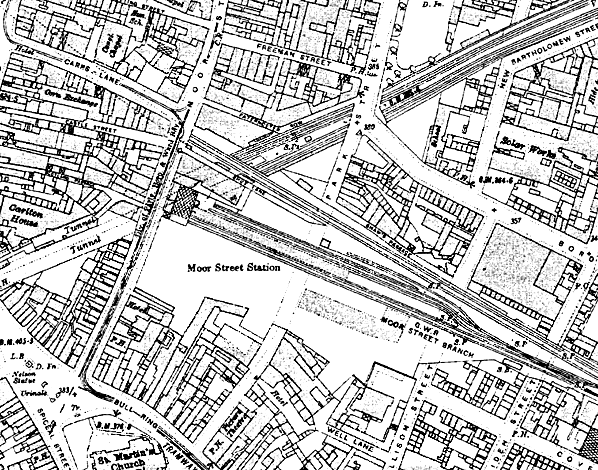
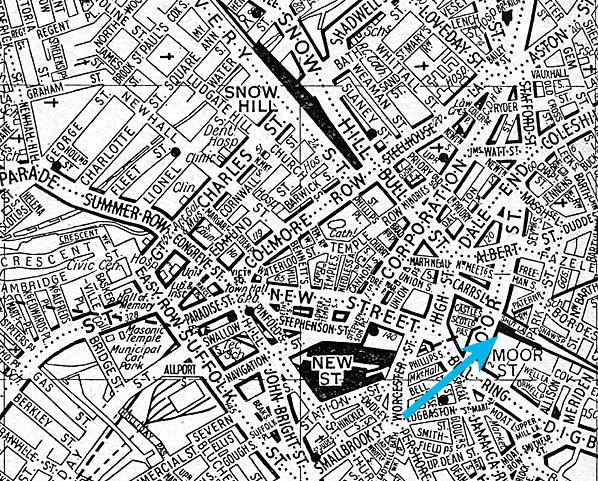
moor_street_old1.jpg)
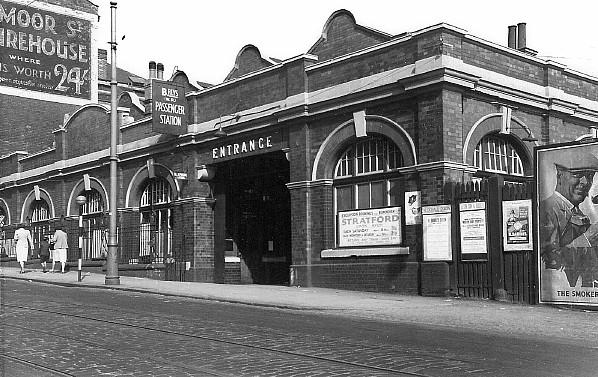
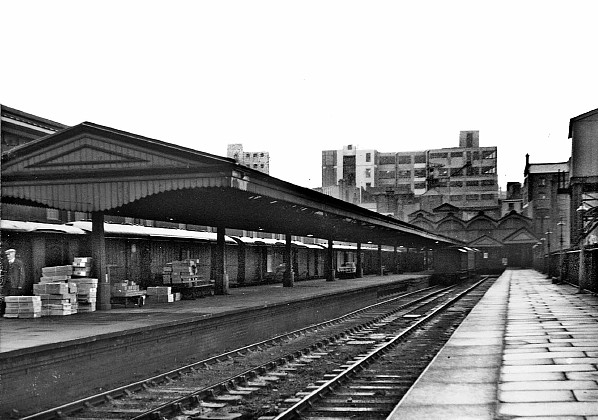
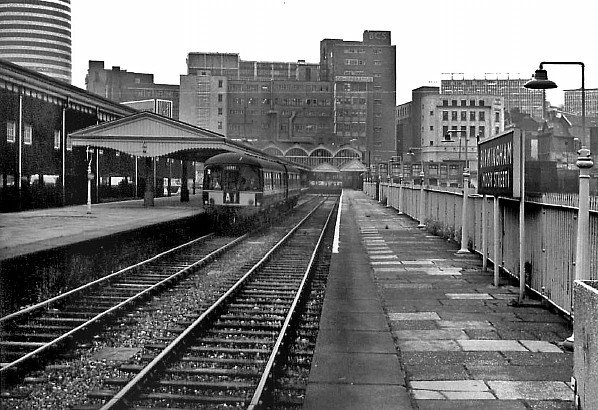
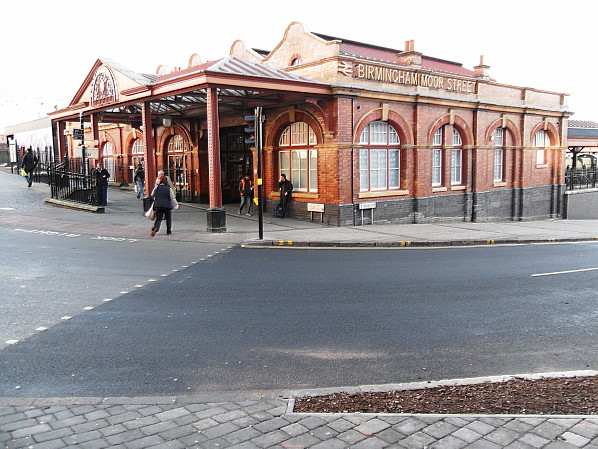
 Home Page
Home Page 

 An interesting feature at Moor Street was a pair of traversers, 60ft in length, located adjacent to the buffer stops. It allowed locomotives to be moved onto an adjacent line so that they could run around their trains. The installation of the traversers meant that points were not needed at the north end of the station, which saved space.
An interesting feature at Moor Street was a pair of traversers, 60ft in length, located adjacent to the buffer stops. It allowed locomotives to be moved onto an adjacent line so that they could run around their trains. The installation of the traversers meant that points were not needed at the north end of the station, which saved space. On 1 January 1948 Birmingham Moor Street became part of British Railways (Western Region). In the immediate period after Nationalisation services continued to run to Henley-in-Arden and Stratford-upon-Avon although some trains ran only as far as Earlswood Lakes. In the summer of 1949 there were 20 departures and 24 arrivals on Monday-to-Friday. There were two fewer departures and six fewer arrivals on Saturday, and the station continued to be closed on Sunday.
On 1 January 1948 Birmingham Moor Street became part of British Railways (Western Region). In the immediate period after Nationalisation services continued to run to Henley-in-Arden and Stratford-upon-Avon although some trains ran only as far as Earlswood Lakes. In the summer of 1949 there were 20 departures and 24 arrivals on Monday-to-Friday. There were two fewer departures and six fewer arrivals on Saturday, and the station continued to be closed on Sunday.  By the 1970s the services running out of Moor Street were supported by the West Midlands Passenger Transport Executive (WMPTE) whose branding was applied to the station. The 5 May 1975 timetable showed 28 departures on Monday-to-Friday with 17 on Saturday, and 26 arrivals on Monday-to -Friday with 17 on Saturday. There had been a significant change by the 1970s with trains arriving at Moor Street having come from Didcot, Banbury, Leamington Spa, Oxford and Stratford-upon-Avon. Strangely there were no corresponding return services; all of these ran to Leamington Spa or Stratford-upon-Avon.
By the 1970s the services running out of Moor Street were supported by the West Midlands Passenger Transport Executive (WMPTE) whose branding was applied to the station. The 5 May 1975 timetable showed 28 departures on Monday-to-Friday with 17 on Saturday, and 26 arrivals on Monday-to -Friday with 17 on Saturday. There had been a significant change by the 1970s with trains arriving at Moor Street having come from Didcot, Banbury, Leamington Spa, Oxford and Stratford-upon-Avon. Strangely there were no corresponding return services; all of these ran to Leamington Spa or Stratford-upon-Avon. The new through station at Moor Street opened on 28 September 1987, with the original terminus seeing its final departure on 26 September 1987. The new Snow Hill station opened on 5 October 1987 and services once again used the broad gauge tunnel under the city.
The new through station at Moor Street opened on 28 September 1987, with the original terminus seeing its final departure on 26 September 1987. The new Snow Hill station opened on 5 October 1987 and services once again used the broad gauge tunnel under the city. In June 1996 M40 Trains, later Chiltern Railways, won the franchise to run the Birmingham Snow Hill to London Marylebone services. The company originally consisted of a number of ex-British Rail (BR) managers, John Laing construction, and 3i. In March 1999 John Laing acquired the 3i stake in the company, along with some of the shares held by the ex-BR managers thus holding 84% of the company. Following the acquisition of the remaining 16%, from the ex-BR managers, Laing was sold to a private equity firm only to be sold on to Deutsche Bahn in 2006. In early 2011 Chiltern Railways was absorbed within the Arriva Group and now has Arriva Trains as its parent company. Contained within the franchise proposals was the reopening of the original Birmingham Moor Street station in order to ease the congestion at Snow Hill. The original platforms reopened on 11 December 2010, the branch having been reconnected to the main line. The first departure from the reopened platforms was a steam special that ran to London Paddington and then returned to Moor Street.
In June 1996 M40 Trains, later Chiltern Railways, won the franchise to run the Birmingham Snow Hill to London Marylebone services. The company originally consisted of a number of ex-British Rail (BR) managers, John Laing construction, and 3i. In March 1999 John Laing acquired the 3i stake in the company, along with some of the shares held by the ex-BR managers thus holding 84% of the company. Following the acquisition of the remaining 16%, from the ex-BR managers, Laing was sold to a private equity firm only to be sold on to Deutsche Bahn in 2006. In early 2011 Chiltern Railways was absorbed within the Arriva Group and now has Arriva Trains as its parent company. Contained within the franchise proposals was the reopening of the original Birmingham Moor Street station in order to ease the congestion at Snow Hill. The original platforms reopened on 11 December 2010, the branch having been reconnected to the main line. The first departure from the reopened platforms was a steam special that ran to London Paddington and then returned to Moor Street.